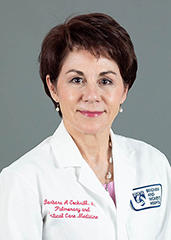The benefits
Students say that having a concrete vignette to refer back to later in their training helps their learning “stick.” Starting the case discussion in small groups allows students to express their ideas in a safe space and learn from each other before sharing in front of the entire class. Moreover, staying in these groups on a four-week rotation builds a community of trust—students are given in-class time to work on team building and communication within their groups. Finally, as students discuss in small groups, faculty circulate around the room and identify which students may be in need of extra academic support and what common misconceptions they should address in the full class discussion.
The challenges
Cockrill explains that one difficulty of the course is keeping the conversation on track while also wanting to be responsive to student curiosities and questions. She works to find ways to encourage student inquiry and curiosity but steer the conversation back to the learning objectives of the day when necessary. “If a student has a lot of clarifying questions, it is important to understand where their confusion is coming from and ensure that they get the help and support that they need outside of class with further resources such as office hours.”
Takeaways and best practices
-
Require students to review concepts as prework.
By assigning readings and information for students to digest prior to the class, many questions can be answered, freeing up class time to address the case in-depth. Students can then apply the broad concepts they have reviewed to a concrete example such as the clinical vignette.
-
Encourage small groups to establish participation norms.
Because students work in the same small groups on a four-week rotation, it is important for them to establish guidelines for working together, so that they move through the cases in the most efficient and supportive way for all group members. Students are given in-class time to work on team building and communication within their groups.
-
Ensure that the case grows in complexity as the class session progresses.
By scaffolding the case and revealing small amounts of information at a time with questions for discussion, students wrestle with the important ideas and concepts and work on applying them in a targeted way.
Bottom line
Cockrill believes that “medicine is all about working in teams to take care of people and using cases to elaborate on that knowledge is really effective.” By studying broad course concepts ahead of class and then devoting in-person time to the case, CBCL can be used to help students apply and expand their knowledge while working on a patient case. Furthermore, by giving students opportunities to discuss in small groups and ultimately as a larger class community, they are able to learn both from the wisdom of their peers as well as from the expertise of the faculty practitioners.
 Barbara Cockrill, Harold Amos Academy Associate Professor of Medicine, uses case-based collaborative learning (CBCL) in her Homeostasis I course to help medical students explore real-life clinical scenarios they may face as practitioners. Case discussions start in cohorts of four students, formed at the beginning of the course, and focus on a series of questions. Discussion continues with the full class of 40 students, facilitated by Cockrill and other medical school faculty.
Barbara Cockrill, Harold Amos Academy Associate Professor of Medicine, uses case-based collaborative learning (CBCL) in her Homeostasis I course to help medical students explore real-life clinical scenarios they may face as practitioners. Case discussions start in cohorts of four students, formed at the beginning of the course, and focus on a series of questions. Discussion continues with the full class of 40 students, facilitated by Cockrill and other medical school faculty.
